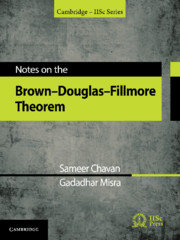Book contents
- Frontmatter
- Dedication
- Contents
- Preface
- From: The Evolution of Modern Analysis, R. G. Douglas
- Overview
- 1 Spectral Theory for Hilbert Space Operators
- 2 Ext(X) as a Semigroup with Identity
- 3 Splitting and the Mayer–Vietoris Sequence
- 4 Determination of Ext(X) as a Group for Planar Sets
- 5 Applications to Operator Theory
- Epilogue
- Appendix A Point Set Topology
- Appendix B Linear Analysis
- Appendix C The Spectral Theorem
- References
- Subject Index
- Index of Symbols
Preface
Published online by Cambridge University Press: 30 June 2021
- Frontmatter
- Dedication
- Contents
- Preface
- From: The Evolution of Modern Analysis, R. G. Douglas
- Overview
- 1 Spectral Theory for Hilbert Space Operators
- 2 Ext(X) as a Semigroup with Identity
- 3 Splitting and the Mayer–Vietoris Sequence
- 4 Determination of Ext(X) as a Group for Planar Sets
- 5 Applications to Operator Theory
- Epilogue
- Appendix A Point Set Topology
- Appendix B Linear Analysis
- Appendix C The Spectral Theorem
- References
- Subject Index
- Index of Symbols
Summary
A well-known theorem of Weyl says that every Hermitian operator on a separable complex Hilbert space is the sum of a diagonal and a compact operator. Halmos raised the question: Is every normal operator the sum of a diagonal and compact operator? Berg and Sikonia, independent of each other, proved that one may replace the Hermitain operators in Weyl’s theorem by normal operators without changing the conclusion. However, this is not true if the operator is essentially normal, that is, its self-commutator is compact. The unilateral shift provides an example of such an operator. The obstruction to the decomposition of an essentially normal operator as a diagonal plus compact operator is a certain index data. This was established in a remarkable theorem by Brown, Douglas, and Fillmore that says that the index is the only obstruction to expressing, up to unitary equivalence, an essentially normal operator as the sum of a diagonal plus compact operator. They showed that the classification of essentially normal operators modulo compact is the same as an equivalence problem of *-monomorphisms of C*-algebras. What has come to be known as the “BDF” theorem provides a solution to this problem. Their proofs are imaginative, novel and use a vast array of techniques and intuition from algebraic topology and homological algebra. This theory, cutting across several different areas, is quite sophisticated. Not surprisingly, therefore, many alternative proofs for different building blocks in the original proof were found soon afterward. So much so that the ingenious original proof in [26], which is a bit terse at some places, was all but forgotten.
These notes follow very closely the initial exposition of Brown, Douglas, and Fillmore [26]. In particular, we have resisted the temptation of giving simpler proofs to many of the arguments, which are now available. Our main goal was to occasionally fill in some details and explain few of the obscure points in the original proof of Brown, Douglas, and Fillmore, which appeared in [26], taking advantage of the exposition in the monograph [47]. In the process, we hope that the reader would develop an interest in modern operator theory and be exposed to some non-trivial techniques.
The first chapter provides standard preparatory material in basic operator theory; we largely follow the exposition of [44].
- Type
- Chapter
- Information
- Notes on the Brown-Douglas-Fillmore Theorem , pp. ix - xiiPublisher: Cambridge University PressPrint publication year: 2021



